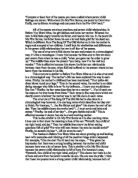The tree symbolizes the birth of a person and, in turn, symbolizes the rebirth of the dead child. The father seems to address the tree as if it is his son, referring to it as “you” and describing entities as “our family.”(Line 26) He also tends to refer dually to the tree and his son as “our native giant.”(Line 11) He also buries among its roots “a lock of hair, a piece of an infant’s chord, all that remains above earth of first-born son”(Lines 13-14), giving the tree a more human characteristic and furthering the idea that the tree represents the son and is in remembrance of his son. It is obvious in these lines that the father is still grieving for his son. The allusion to Italian customs and how he would’ve “celebrate[d] his first son’s birth”(Line 6) shows the love he had for his son and still has. This idea of love is even more obvious in the fact that he’s planting a tree to commemorate his existence and allow him to live on in some form. Gioia is kind of passing on the life of his son into this tree. The passing of one life has been transformed into the creation of a new one.
This piece especially concerns nature. This is a strong element because it is enduring magnificence of nature that most resembles how Gioia would like his son’s legacy to be. This is ever-present also in the fact that the process of a tree growing takes place over a long period of years and is a slow, natural process. Gioia address the shrub or seedling they are planting as if it is his son, putting him in the ground only to grow to be big and strong. Just as the child is borne of the mother, the tree is borne of the ground. It’s essentially a rebirthing for the son, “a promise of new fruits in other autumns.”(Line 10) His son’s new home is in the earth, protected by the earth, but with “nights scented with the ocean fog, days softened by the circuit of bees.” (Line 18) He has entrusted nature to help bring up this tree but also has given himself, his work and his land, to help this tree grow. In a way, the shrub is growing from a part of Gioia, more specifically, Gioia’s land. It’s also important to note that it takes at least three people, Gioia and his brothers, to plant this tiny shoot, this small plant. This shows how much care they’re taking in the process and how important it is to Gioia.
The poem is written in free with verse with no rhymed couples or rhyme scheme at all. It seems more like the poet’s speaking directly to his child while allowing the reader to be a witness to the scene. The reader learns a lot of the scene through Gioia’s dialog with his son. The comparison of the infant to the young plant is a conceit that helps the reader to further understand the author’s actions and care with the plant. Each stanza ends with a rather dramatic line, each line encapsulating the idea of the stanza, offering hope or closure. The personification of the tree in the last stanza, with it “stand[ing] among strangers”(Line 24) is a pretty powerful line. A tree can stand erect, but someone that stands usually holds a position or purpose and remains firm and strong in spite of difficulty, or, in this case, being alone and amongst strangers in the future.
The diction of this poem reflects a melodic and sentimental mood but it also has a very graceful fluidity to it. The variation of the accents of each line adds spontaneity and freedom to the work. The cadence brings the reader into the scene by making the reader feel as though the actions are happening in the present and help the reader to understand the true weight of Gioia’s presence. The concrete diction helps the reader even more to perceive the scene through one’s own senses.
It is obviously a somber occasion, with Gioia referring to this burial happening in the cold and not speaking of anything else. But, there is an overwhelming sense of hope in the poem. Gioia creates this scene by having planted the roots in “the corner of the grove, bathed in western light” (Line 19) and creating this image of “a slender shoot against the sunset” (Line 20). This is an incredibly striking visual image in that it shows the tiny plant basking in the light of the sun, growing slowly, one day becoming this enormous tree. It's an important occasion because he’s passing life into this tree. The last line “silently keeping the secret of your birth”(Line 25) is the author’s acknowledgements of the events of the stillborn birth but also a look towards the future and the ability to overcome the grief that he suffered through as a result of the situation.
Gioia has turned a very somber occasion into one of hope and honor. The poem seems to be his moment when he gets to acknowledge the events that have happened and say a final farewell to his son. It’s a poem of rebirth and portrays an optimistic outlook on the future. The tree takes on the life of his son and continues it for years and years to come.







